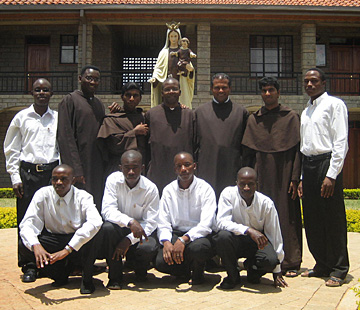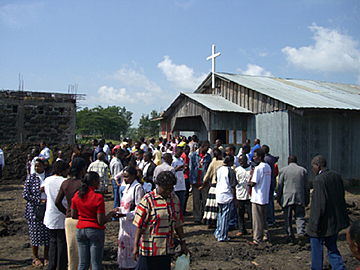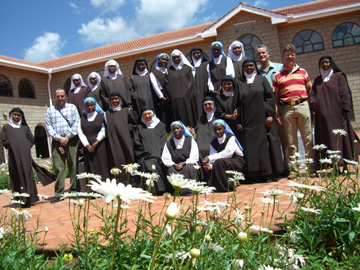|
no. 2 april - june 2007
Bustani ya Karmeli stands for "Garden of Carmel" and is the name of the foundation of Carmelites in Nkoroi, just outside Nairobi, Kenya. In 1994, the first group of five students from Kenya went to Spain and joined the Catalonian Province. They had been selected by two Carmelites of Mary Immaculate (CMI), the India based Order. Two remained to be solemnly professed and ordained. In July 2004, Onesmus Muthoka and Boniface Kimondolo were the first Kenyan Carmelites to be ordained. In 1997, the Arago-Valencia Province recruited three men from Kenya. One, Stephen Mweu, who made his Solemn Profession in September 2005, remains. In 2001, the Indian Commissariat sent two members, John Neerolickal and Felix Pallipatt, to make a foundation in Kenya. In 2004, Soni Abraham joined his Commissariat brothers in order to coordinate construction projects. On June 9, 2004, Bishop Cornelius Schiler, of the Diocese of Ngong, officiated at the ground breaking ceremony for the new monastery at Bustani ya Karmeli. Construction began at the beginning in October and the blessing of the new building took place on June 29, 2005.
St. Charles Lwanga has 400 families who are divided into six small Christian communities. There are two Sunday liturgies, one in English and one in Swahili, and the small church is packed for both. The parishioners are looking forward to moving into their new church building which will be directly behind the current chapel. The current community is made up of two Kenyan priests (members of the Catalonian Province), two priests from the Indian Commissariat, six Kenyan students, and 2 professed Indian students. The Carmelites first came to Kenya in 1956. Eight Spanish Carmelite nuns from Utrera made a foundation in the Diocese of Kisumu. After a few years, some of the nuns were constricted to return to Utrera because of poor health. Other nuns came from Utrera. Due to the lack of security, the nuns were forced to move. Eventually that monastery transferred to the Discalced Carmelites. But the missionary spirit remained very much alive in the Utrera monastery. A Carmelite of Mary Immaculate (CMI), Fr. Edward Padikalla, was working in India and established contact between some young women in his parish and the nuns in Utrera. Three of the Kenyans went to Utrera in 1984 with the idea of their returning to Kenya to found another monastery. Fifteen years later, the dream became reality. In 1999, the Kenyan Carmelites returned to a great welcome from the Bishop of Machakos on what happened to be the Silver Jubilee of his Episcopal ordination. The foundation in Machakos began in October with seven nuns from Utrera, including two Spaniards, four from the Diocese of Machakos, and one from the Archdiocese of Nairobi. The monastery was officially opened on October 15, 2004. The Lord has blessed the foundation with many vocations since. The community today numbers more than 15 members. The enclosed Carmelite monastery in Juja is a foundation made from the Federation of Carmelite nuns in northern Spain, Verge Flos del Carmel (Catalonia, Spain). The nuns of the monastery of the Presentation of Mary in Valls (Tarragona) accepted responsibility for the foundation. It was decided to open the nuns’ monastery in the same diocese as the Carmelite men. The Bishop of Ngong granted permission and gave over a house in Oloikirikirai which other sisters have left in 1992 due to tribal clashes. The Carmelites left Catalonia on April 1st and found the house unsuitable. The bishop insisted that the sisters remain but the Archbishop of Nairobi welcomed them although they initially stayed with the Carmelites in Machakos for a little more then three months. They then moved into temporary quarters which accommodates 10 nuns in Juja in the Archdiocese of Nairobi and are now awaiting the completion of their monastery. The new monastery is on six hectares of land. Juja Farm is in the Kenyan Central Province in the Thika District about 46 km from Nairobi. The area is semi arid. The people from Juja Farm come from the Kikuyu tribe. The monastery has six members: one Spaniard and one Kenyan in solemn vows, one simply professed and two postulants. The Lay Carmelites have been in Kenya for over 40 years under the direction of a Consolata priest, Fr. Joseph Demarie. Beginning in 1964 in Nkubu, Meru, the Lay Carmelites now count over 2,400 members. Once the Carmelites from India arrived, Fr. Demarie turned over responsibility for the Lay Carmelites. The movement has spread throughout Kenya under the leadership of a National Council. Many of the members are isolated and a bi-monthly publication The Scapular was established to maintain contact. The members come together as often as possible given the distances. Once a year, all the members make a retreat together. The retreat in 2006 ran from April 25-29. The future of Lay Carmelites in Kenya appears bright. The movement is spreading throughout the various secondary schools throughout the nation. Among the Lay Carmelites in Kenya are the Donum Dei who arrived in 1999. Their numbers have been growing as a result of their formation house in Nairobi. It is the mission of the Donum Dei to bring Jesus to those who live far away from Him. Today these Lay Carmelite women have nine members, including six aspirants. The Carmelite nuns of Machakos use the traditional Kenyan greeting "God is good" with the response "All the time" with new fervor. In March, 2006 two of the sisters,Mon Magdalene and Winfred, were being driven to Nairobi where they were to visit the prioress, Sr. Margarita Vargas, who had surgery that morning. Just a few kilometers from the monastery, a speeding matatu, the Kenyan mini vans loaded with passengers which clog the roads, tried to overtake the vehicle with the nuns. The matatu clipped the front of the car with the sisters in it when he attempted to re-enter the lane. The sisters’ driver lost control of the van and it rolled over in the middle of the road, ending upside down. A couple driving a family car stopped and helped the sisters out of their vehicle. They were rushed to a nearby hospital and later transferred to Nairobi—to the same hospital where Sr. Margarita was recouperating. In fact, St. Magdalena was admitted to the bed next to Sr. Margarita’s. The other two occupants of the car, Sr. Winfred and the driver were only slightly injured and were discharged from the hospital that same day.
Update on Africa Zimbabwe has had the longest, continuous Carmelite presence in Africa—some 60 years ago it was started by the Irish Province. The Commissariat has nine communities in two dioceses. Its high school for young women is considered one of the best in the country. In 2004 the members of the Commissariat held an Extraordinary Assembly to produce policy in the areas of vocations, formation, Carmelite spirituality, community life, ministry, and education/on-going formation. The Commissariat has 31 members in final vows, 17 of whom are Zimbabwean. Twelve members are in simple vows and there are four novices. The Commissariat has parishes, schools, and its members do retreats, hospital chaplaincy, and formation. Simplisio Manyika, is the first native Zimbabwean to serve as Commissary Provincial. Democratic Republic of the Congo The Carmelite mission in the DR Congo started in 1973 from the Roman (now "Italian") Province. It has been a Provincial Commissariat since 1994. The Commissariat has 101 members with 40 solemnly professed and 11 novices. The Commissariat has six communities, three formation houses, and three parishes. Five Congolese Carmelites serve in Cameroon, four are in Italy, one is in Colombia, and one is in France. In recent years the country has been victimized by much violence. In Bunia, where the Commissariat has the novitiate, more than 200 refugees were fed and given health care. A medical and health center was recently inaugurated. The parish of Nioka has been frequently attacked by rebels but the Carmelites have never abandoned it. The Carmelites arrived in Burkino Faso, one of the poorest countries in the world, in 2000. An estimated 82% of its 14 million inhabitants live in the rural areas. Some 12% are Catholic and 25% are Muslim. The majority belong to native religions. The novitiate opened in 2003. There are now eight members in simple vows, five in solemn vows, and five postulants. The Baetica Province, which is responsible for the mission, is building a house in Bobo Dioulasso. The mission participates in parish work, youth and prison ministry, and orphanages. The members give courses on the Bible and lectio divina. With assistance of the Irish Province, the General Commissariate of Portugal and the General Curia, the Pernambuco Province began a mission in Gorongosa, Mozambique in 1997. The Carmelites aided in the restoration of the structures of the mission— school, church, mission, etc—after a long civil war. In 2004, the members moved to Maputo to begin formation work which the bishop of Gorongosa did not allow. There are now 11 in formation in Maputo; however, the novitiate has yet to begin. It is estimated that the country’s unemployment rate is 40%. Having gained independence from Great Britain and France in 1960, Cameroon now enjoys guaranteed liberties, free speech, etc. While 80% of the people are literate, life expectancy is only 48 years. Catholics make up 33% of the population. Many sects are gaining membership. Donum Dei arrived in 1990 and nurtured Carmelite vocations among young men. Now there are two parishes, a novitiate and a scholasticate. Nine members are in solemn vows and 23 are in simple vows. A pig farm, hens and palm trees help finance the missions. Members of the Italian Province and the Congolese Commissariat assist the Lower German Province in the mission. With a population of 34 million people, the country’s Catholics make up 75% of the total. While 43% of the population is younger than 15 years of age, the life expectancy is only 45 years. The mission was founded by the Indian Commissariate in 2001 when two men traveled to Kenya. Two Kenyans had previously gone to the Catalonian Province and three had gone to the Arago-Valentina Province for studies. Currently the mission has two native Kenyan priests, two Indian priests, two Indian students, and six Kenyan postulants. There is a large Lay Carmelite presence with about 350 members. Tangaza College which is near the foundation could provide an educational center for students from outside Kenya. In 2007, a new parish church was dedicated. (see related stories 1 | 2). The General Commissariat of La Bruna intends to build a formation center and shrine near Dar-Es-Salam. There are two Tanzanian priests in Naples, Italy and six in formation. The hope is to begin a foundation next year. |
|
RETURN TO THE INDEX FOR 2007 | RETURN TO THE INDEX FOR THIS ISSUE INDEX OF CARMELITE
WEBSITES |

 Bustani ya Karmeli Flourishes in Kenya
Bustani ya Karmeli Flourishes in Kenya Bustani ya Karmeli was built opposite an "outstation" (chapel) of a
nearby parish. Since the arrival of the Carmelites at the station, Bishop
Schilder raised the outstation to a parish, St. Charles Lwanga, the
Ugandian martyr from the 1880s. It was good to have a parish from the very
beginning.
Bustani ya Karmeli was built opposite an "outstation" (chapel) of a
nearby parish. Since the arrival of the Carmelites at the station, Bishop
Schilder raised the outstation to a parish, St. Charles Lwanga, the
Ugandian martyr from the 1880s. It was good to have a parish from the very
beginning.